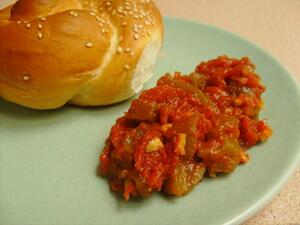Eating Jewish: Salade Cuite (Moroccan Matbucha)
I remember being enamored by the various small salads that were placed on the table to begin the meal at the first Shabbat dinner I attended that was hosted by my friend’s parents, of whom her father is Moroccan. The salads, of which there was, among others, corn salad, avocado salad, roasted red peppers, beets, radishes, and of course salade cuite, which literally means "cooked salad" in English, were a nice way to start the meal. The salade cuite came highly recommended by my friend, who loves it and can’t have Shabbat dinner without it. I loved the salade cuite as soon as I tasted it and despite the fact that all the salads were delicious, this was definitely the standout. It was so easy to eat and I had to remind myself that there was more food to come. The mix of tomatoes, bell peppers and garlic was addictive and perfect for dipping bread into.
This traditional salad comes from the Moroccan Jewish community, which was the largest Jewish community in North Africa in the nineteenth and twentieth centuries as stated in this article in Jewish Women: A Comprehensive Historical Encyclopedia, which provides the reader with interesting information about women’s gender roles in this community. A large number of people from the Moroccan Jewish community immigrated to Israel, as well as the US and Canada during the twentieth century. Yet through these moves, traditional recipes, such as salade cuite have been carried to the new homes in which families from this community have settled, and work as a strong link to a country that once called home. This salad is usually served on Shabbat due to the fact that it’s a make-ahead salad, as many of the salads served by Moroccans on their Shabbat tables are.
Salade cuite is easy to throw together, the longest part being charring and then peeling the peppers. Charring the peppers over the flame of my gas stove was my favorite part of the process (despite being slightly scared about doing this over an open flame in my kitchen!). Hearing the skin of the peppers crackle as they began to blacken and then to smell the sweet, smoky aroma of the peppers as they cooked brought me right back to my childhood when my mom used to roast peppers on our barbecue in the backyard. Once the peppers have been charred and peeled, you just have to put them in a skillet along with the rest of the ingredients and cook it until the mixture becomes thick. The one thing to remember when cooking this dish is the advice given by Mrs. Zrihen, the woman who gave Joan Nathan this recipe, which is to cook the salade cuite slowly, “until the eye eats.” Once it is ready to eat, you can serve it with the bread of your choice, but I think that scooping it up with some fresh challah is the best way to eat it.
I hadn’t attempted to make salade cuite before and when I wanted some for Shabbat dinner, I would go out and simply buy some. Although, now that I’ve made this delicious salad myself I know I definitely won’t be buying the pre-made kind again. Go ahead and make this salad too, it will definitely bring a taste of Morocco to your table.
Salade Cuite (Moroccan Matbucha)
From Joan Nathan’s The Foods of Israel Today
4 green bell peppers
¼ cup extra virgin olive oil
3 pounds very ripe fresh tomatoes (about 8), peeled, seeded, and diced, or one 32-ounce can diced tomatoes, drained
6 cloves garlic, minced
1 teaspoon sugar
2 teaspoons sweet paprika
1 teaspoon salt, or to taste
Freshly ground pepper to taste
Argan or extra virgin olive oil for drizzling
-
Put the whole peppers on a baking tray under the broiler, turning frequently with tongs, until they are charred on all sides, about 20 minutes. If you have a gas stove, you can also char the peppers by placing them over the flame and turning them until their skin is black. Place them in a tightly closed plastic bag (I used Ziploc bags for this and they worked well) for 10 minutes to allow the skins to loosen. Peel the charred skin from the peppers (I recommend doing this over a plastic bag that’s been cut open down one side so your counter doesn’t get too messy), discard the seeds, and cut into 1-inch squares.
-
Heat the oil in a skillet, and add the peppers, tomatoes, garlic, sugar, paprika, salt, and pepper to taste. Simmer over a low flame, stirring occasionally and mashing the vegetables with a fork until the liquid begins to evaporate. Continue cooking until the salad has a thick, sauce-like consistency.
-
Drizzle with the argan or olive oil and serve at room temperature.








Yum! I added some black olives toward the end as well. Thanks.
I once learned to make matboucha from a very kind woman in the Rabat mellah over a canister of propane and an open fire; a harrowing and delicious experience. Thanks for posting this!